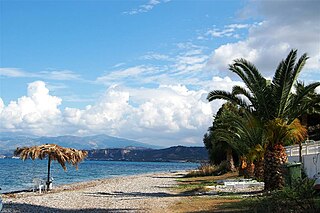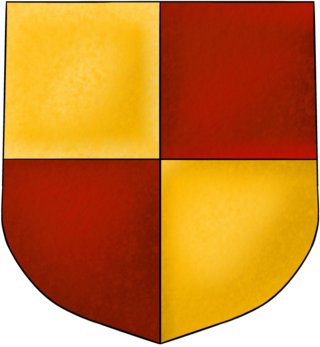Related Research Articles

Alissos is a village and a community in the municipal unit of Dymi, Achaea, Greece. It is located near the Gulf of Patras, 3 km east of Kato Achaia, 3 km southwest of Kaminia and 17 km southwest of Patras. The community consists of the villages Alissos, Kamenitsa, Paralia Alissou and Profitis Elissaios. The Greek National Road 9 and the railway from Patras to Pyrgos run between Alissos and Paralia Alissou.

Centurione II AsanesZaccaria, scion of a powerful Genoese merchant family established in the Morea since the marriage of the lord of Chios Martino Zaccaria to the baroness Jacqueline de la Roche. Centurione was installed as Prince of Achaea by Ladislaus of Naples in 1404 and was the last ruler of the once Latin Empire not under Byzantine suzerainty.
Andronikos Asen was the epitropos of the Byzantine province of the Morea between 1316 and 1322.
Centurione I Zaccaria was one of the most powerful nobles of the Principality of Achaea in the 14th century. He was the firstborn son of Martino Zaccaria and Jackqueline de la Roche, last representant of the prestigious Burgundian house of the Duchy of Athens. In 1334 Centurione succeeded his brother, Bartolomeo Zaccaria as baron of Damala. After the death of Martino he rose as lord of one half of the Barony of Chalandritsa, and in 1359 he acquired the other half. In about 1370 he was named Grand Constable of Achaea and received also the Barony of Estamira. He also thrice held the post of bailli (viceroy) for the principality's Angevin rulers.

Maria II Zaccaria Asanina was a Princess of Achaea.

The Barony of Vostitsa was a medieval Frankish fiefdom of the Principality of Achaea, located in the northern coast of the Peloponnese peninsula in Greece, centred on the town of Vostitsa.

The Barony of Arcadia was a medieval Frankish fiefdom of the Principality of Achaea, located on the western coast of the Peloponnese peninsula in Greece, and centred on the town of Arcadia, ancient and modern Kyparissia.

The Barony of Chalandritsa was a medieval Frankish fiefdom of the Principality of Achaea, located in the northern Peloponnese peninsula in Greece, and centred on the town of Chalandritsa south of Patras.

The Barony of Veligosti or Veligosti–Damala was a medieval Frankish fiefdom of the Principality of Achaea, originally centred on Veligosti in southern Arcadia, but also came to include the area of Damala in the Argolid when it came under a cadet branch of the de la Roche family in the 1250s. After Veligosti was lost to the Byzantines towards 1300, the name was retained even though the barony was reduced to Damala.
Andronikos Asen Zaccaria or Asanes Zaccaria was a Genoese lord of the Principality of Achaea in southern Greece.

John Asen Zaccaria or Asanes Zaccaria was a son of Centurione II Zaccaria and one unknown lady of the great Byzantine family of Asen - Palaiologos.
Stephen Zaccaria was the youngest brother of the last Prince of Achaea, Centurione II Zaccaria, and Latin Archbishop of Patras from 1404 until his death in 1424.

The Battle of Picotin was fought on 22 February 1316 between the Catalan forces of the infante Ferdinand of Majorca, claimant to the Principality of Achaea, and the forces loyal to Princess Matilda of Hainaut, comprising native levies from the barons loyal to the Princess as well as Burgundian knights. The battle ended in a crushing victory for Ferdinand, but he was later engaged and killed by the troops of Matilda's husband, Louis of Burgundy, at the Battle of Manolada.
Guibert of Cors was a French knight and Baron of Mitopoli in the Principality of Achaea. Guibert was married to Margaret of Nully, daughter of the Lord of Passavas John of Nully. He was killed in 1258 in the Battle of Karydi.

The Battle of Geraki took place in c. 1375 between the Latin Principality of Achaea and the Byzantine Greek Despotate of the Morea, at the fortress of Gardiki in Arcadia, southern Greece.
Erard III Le Maure was Baron of Arcadia and Marshal of the Principality of Achaea in the mid-14th century.
Geoffrey of Aulnay was Baron of Arcadia in the Principality of Achaea in the late 13th century.
Vilain II of Aulnay was Baron of Arcadia in the Principality of Achaea in the early 14th century.

The House of Zaccaria-Damalà, or commonly Damalas, is a Genoese-Byzantine noble House established in the 14th century; originating from the island of Chios during the first Genoese occupation. It was created as the result of the marriage between a sister of Emperor Michael VIII Palaiologos with Benedetto I Zaccaria, causing this branch of the Zaccaria to grow roots in Byzantium and subsequently the Principality of Achaea through the Barony of Damalà.
Asenina-Palaiologina was the wife of Centurione II Zaccaria, one of the last Princes of Achaea (1404-1429) and after her marriage, she became consort of the Latin Principality.
References
- 1 2 Guérin, Marie (2014). Les dames de la Morée franque (XIIIe-XVe siècle) : Représentation, rôle et pouvoir des femmes de l’élite latine en Grèce médiévale. Université Paris-Sorbonne. p. 67.
- ↑ Guérin, Marie (2014). Les dames de la Morée franque (XIIIe-XVe siècle) : Représentation, rôle et pouvoir des femmes de l’élite latine en Grèce médiévale. Université Paris-Sorbonne. p. 313.
- ↑ Thomopoulos, Stephanos. History of the city of Patras, from the ancient times until 1821 (in Greek). p. 528. ISBN 960-7960-08-4.
- ↑ Shawcross, Teresa (2009). The Chronicle of Morea Historiography in Crusader Greece. Oxford University Press. p. 105.
- ↑ Shawcross, Teresa (2009). The Chronicle of Morea Historiography in Crusader Greece. Oxford University Press. p. 106.